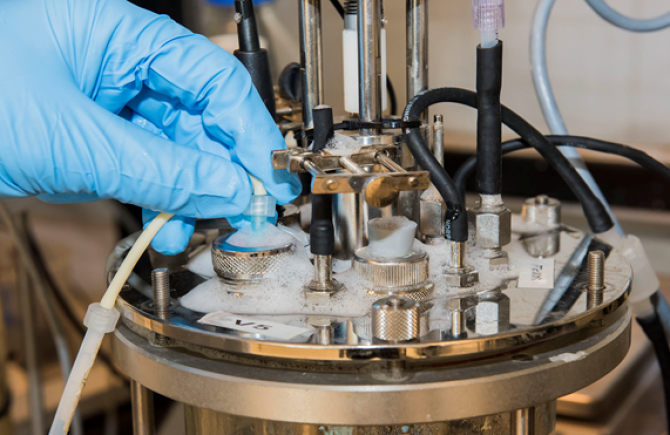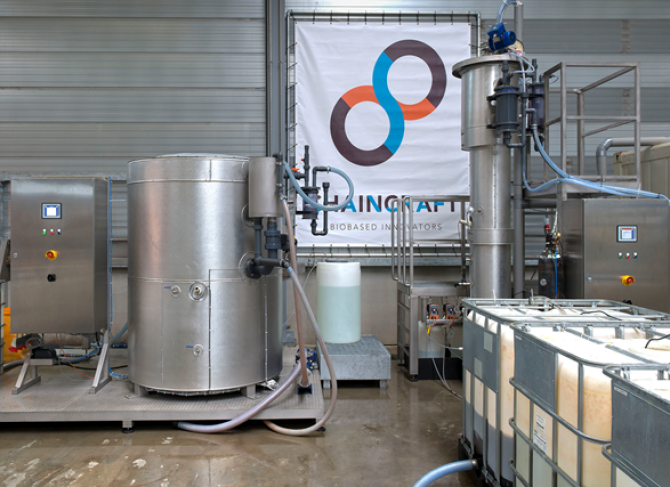
News
Spin-off: From organic waste to valuable chemical building blocks
ETE’s research regularly results in patents and the establishment of spin-of companies. ChainCraft was founded in 2010 as a direct result of ETE’s discovery of a microbiological process where organic waste is converted into valuable chemical building blocks. The young company is now planning a demonstration factory that is economically viable and where the process is optimized.
A heavy, acidic smell penetrates my nose when I enter the huge factory hall of waste management concern Simadan BV in Amsterdam. Long rows of colored containers with organic waste are waiting to be processed to biogas. In a modest corner of the hall a few shiny stainless steel vessels contrast with the pungent smell. This is the pilot plant of ChainCraft. Organic waste serves a different purpose here: the manufacturing of sustainable biobased chemicals that can be used as building blocks for a variety of products. ‘Our aim is to contribute to the biobased economy by converting waste into valuable raw materials without depletion of natural resources’, ChainCraft director Niels van Stralen explains. ‘We are working to optimize and commercialize the process of manufacturing high-value chemicals derived from waste streams.’

High-value chemical
ChainCraft, formerly called Waste2Chemical, was founded in 2010 as a spin-off of research carried out at ETE. In 2007 Ph.D. student Kirsten Steinbusch by coincidence discovered that microorganisms could convert volatile fatty acids (VFA’s), small molecules derived from fermented organic waste, into caproate, a much larger molecule. This high-value chemical is a raw material for food, feed, pharma as well as a range of chemical materials. The caproate formation process was described in detail and subsequently patented by ETE. ChainCraft bought the patent and started the laborious process to commercialize production. Several investors, such as Dutch Greentech Fund and Horizon 3, financed the spin-off, and the young company set-up a research lab. Three years ago the small team delivered the proof of concept on lab scale and a next step to scale the process was taken. Van Stralen points at the shiny stainless steel components of their test facility. ‘In 2014 this pilot plant was operational’, he says. ‘Here we test and optimize the process at an approximately 500 times bigger scale than in de lab.’
Economic viability
The results from the pilot plant experiments were very promising. ‘The process works essentially similar as in the lab; we proved the technological feasibility of the process at this bigger scale’, van Stralen states. ‘But we still have to demonstrate the economic viability of the process.’
To test this, the research and development team needs to scale the process even more. For this reason, they have planned to realize a demonstration factory in 2017, where we can operate at again a 500 times bigger scale than the pilot plant.

Lasting impact
In addition to establishing a profitable demonstration factory, ChainCraft is planning more activities related to creating valuable components from waste. The technical and economic optimization of new processes will be incorporated in their research. Collaborations with ETE and other parties are part of ChainCraft’s strategy. ‘ETE still plays an important role in our activities and we still work closely together in some scientific areas’, van Stralen explains. ‘Examples are R&D of new processes and joint grant applications.’
The future for ChainCraft looks bright and their team of dedicated researchers and engineers is determined to have an important contribution to manufacturing valuable components from waste. Van Stralen enjoys having a broad overview of the company’s different activities: ‘I feel like a spider in a web and I appreciate connecting different aspects of ChainCraft’s R&D, financing, business development and team to have a lasting impact on a more sustainable society.’